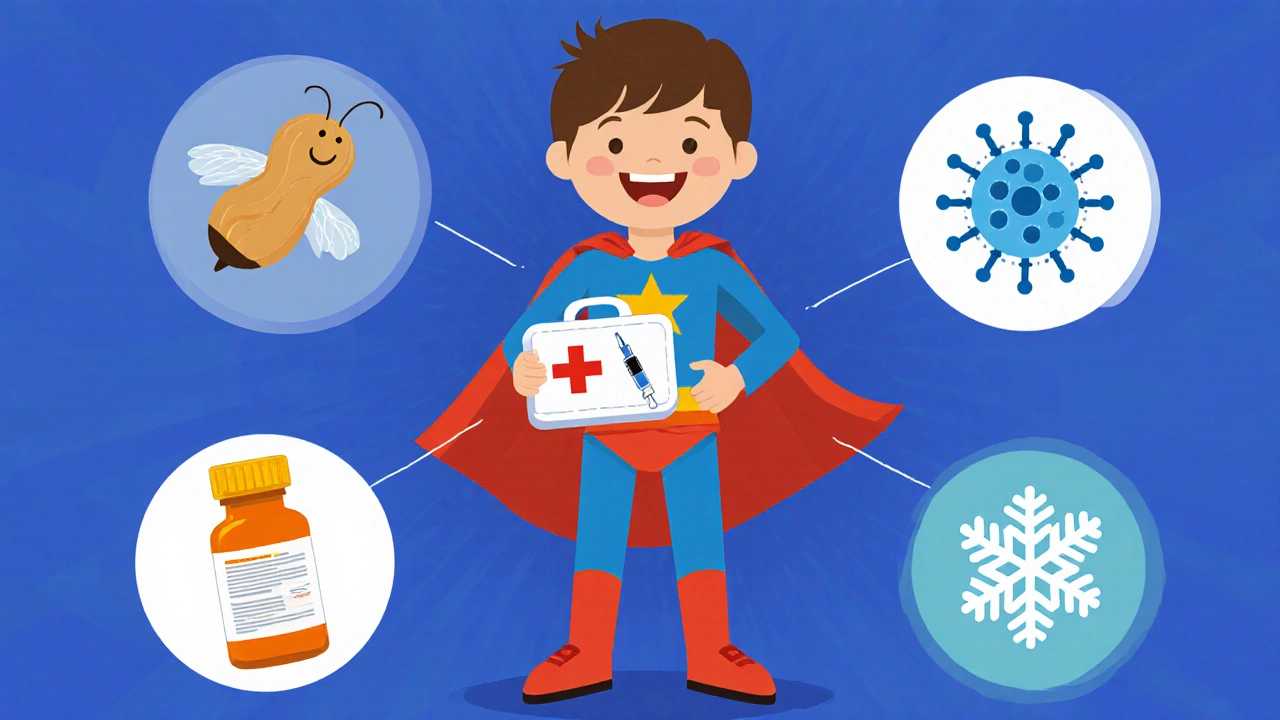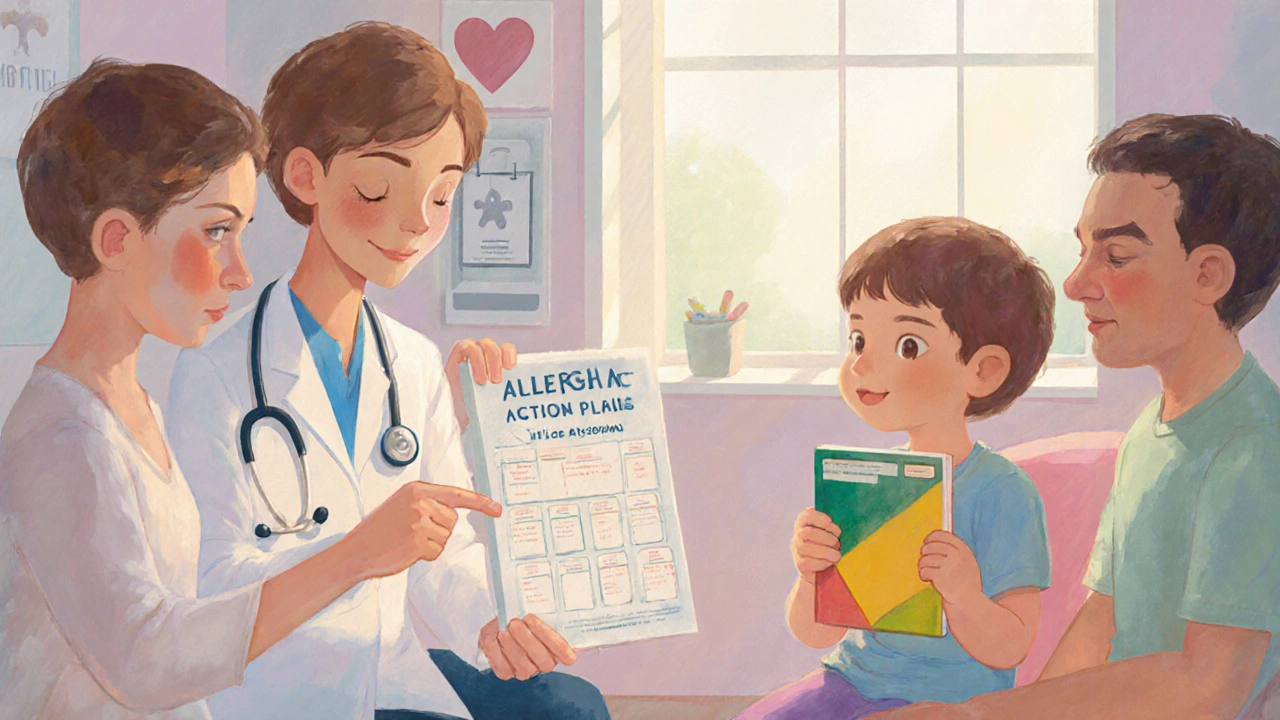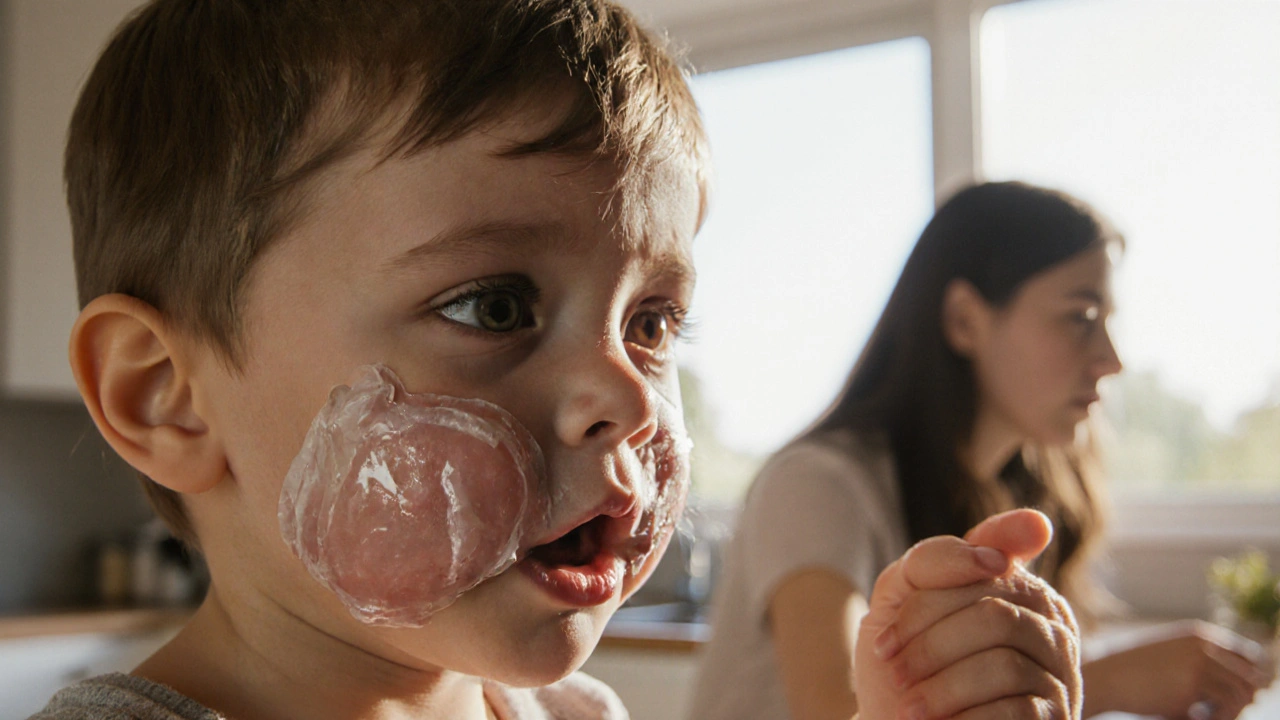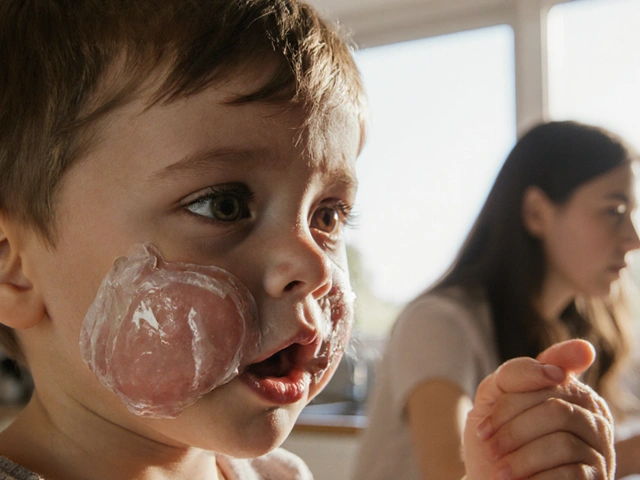Child Angioedema Trigger Identifier
Potential Triggers
Food Allergens
Peanuts, tree nuts, shellfish, eggs, dairy
Insect Stings
Bees, wasps, mosquitoes
Medications
Penicillin, NSAIDs, ACE inhibitors
Infections
Viral respiratory infections
Physical Factors
Cold, heat, pressure
Stress/Emotional
Emotional stress or change
When a child’s face, lips, or throat suddenly swell, it could be angioedema - a rapid, deep swelling of the skin and mucous membranes that can affect the eyes, lips, tongue, or airway. Angioedema in children can feel scary, but understanding what’s happening and how to act can keep everyone safe.
Key Takeaways
- Angioedema is a sudden swelling that can involve the skin, lips, tongue, or airway.
- Triggers include foods, insect bites, medications, infections, and rare genetic causes.
- Watch for warning signs like difficulty breathing, swallowing, or swelling that spreads quickly.
- Emergency treatment often involves antihistamines, corticosteroids, and, in severe cases, epinephrine.
- A clear action plan with your pediatrician helps prevent future episodes and reduces anxiety.
What Exactly Is Angioedema?
Angioedema differs from a simple rash. While hives (urticaria) sit on the surface, angioedema pushes deeper into the dermis and subcutaneous tissue, creating a puffier, sometimes painful swelling. In children, the most common form is histamine‑mediated, linked to allergic reactions. A less common, but important, variant is hereditary angioedema (HAE), caused by a deficiency or dysfunction of the C1 inhibitor protein.
Common Triggers in Kids
Knowing the usual culprits helps you spot patterns early. Below are the top triggers you might encounter:
- Food allergens: peanuts, tree nuts, shellfish, eggs, and dairy are frequent offenders.
- Insect stings: bees, wasps, and even mosquito bites can set off swelling.
- Medications: antibiotics (especially penicillins), non‑steroidal anti‑inflammatory drugs (NSAIDs), and ACE inhibitors are notable triggers.
- Infections: viral upper‑respiratory infections sometimes cause an angioedema flare.
- Physical factors: pressure, cold, or heat can provoke a reaction in some children.
Hereditary angioedema isn’t linked to these typical allergens. Instead, it often flares without an obvious trigger, sometimes after stress, trauma, or hormonal changes.

When to Call 911 or Rush to the Emergency Department
Most episodes are mild and resolve with home care, but a few signs demand immediate medical attention:
- Swelling of the tongue, lips, or throat that makes speaking or breathing difficult.
- Rapid spread of swelling (within minutes) especially around the airway.
- Sudden drop in blood pressure, dizziness, or fainting.
- Hives combined with swelling, indicating a possible anaphylactic reaction.
If any of these appear, dial emergency services right away. Even if you’re unsure, it’s safer to err on the side of caution.
How Doctors Diagnose Angioedema
A pediatrician will start with a detailed history: timing of the swelling, suspected foods or medicines, family history, and any associated symptoms like abdominal pain. Physical examination looks for the characteristic deep, non‑pitting edema.
Lab tests differ based on the suspected type:
- Allergic (histamine‑mediated) angioedema: often no specific blood test, but a serum tryptase level may rise after a severe reaction.
- Hereditary angioedema: measurement of C4 complement levels and functional C1 inhibitor activity. Low C4 with low or dysfunctional C1‑inhibitor confirms the diagnosis.
In uncertain cases, allergy skin prick testing or specific IgE blood tests help pinpoint food or inhalant triggers.
Treatment Options: What Parents Can Expect
Therapy is tailored to the underlying cause and severity.
For mild, histamine‑mediated episodes, over‑the‑counter antihistamines (e.g., cetirizine or loratadine) are often sufficient. Oral corticosteroids (prednisone) may be added if swelling persists beyond a few hours.
For moderate to severe reactions, physicians may administer:
- Epinephrine (auto‑injector) - the first line if airway compromise is looming.
- Intravenous antihistamines and corticosteroids for faster control.
Hereditary angioedema requires a different approach because antihistamines and epinephrine are ineffective. Approved treatments include:
- C1‑esterase inhibitor concentrate (plasma‑derived or recombinant) given intravenously.
- Bradykinin‑B2 receptor antagonist (icatibant) for acute attacks.
- Short‑term oral androgens (e.g., danazol) or newer prophylactic agents for preventing future attacks.
Managing Angioedema at Home
Even after a pediatrician sets the plan, day‑to‑day vigilance matters.
- Keep an Emergency Kit: Antihistamine tablets, a prescribed short‑course steroid pack, and, if advised, an epinephrine auto‑injector.
- Identify Triggers: Use a simple diary to log foods, medications, and activities before each episode.
- Practice the Action Plan: Review steps with your child (age‑appropriate) so everyone knows the sequence - stop the suspected trigger, give medication, call for help if breathing is affected.
- Educate Caregivers: Ensure teachers, babysitters, and relatives know the signs and have the emergency kit.
- Follow‑up Regularly: Quarterly visits with the allergist or immunologist keep the treatment regimen up‑to‑date.

Comparison of Allergic vs. Hereditary Angioedema in Children
| Aspect | Allergic (Histamine‑Mediated) | Hereditary Angioedema |
|---|---|---|
| Typical Triggers | Foods, insect stings, drugs, latex | Often none; stress, trauma, hormonal changes |
| Onset Speed | Minutes to an hour | Hours to days |
| Lab Findings | Normal C4, possible elevated tryptase | Low C4, low or dysfunctional C1‑inhibitor |
| First‑line Treatment | Antihistamines, corticosteroids, epinephrine (if severe) | C1‑esterase inhibitor concentrate, bradykinin antagonist |
| Prophylaxis | Avoid known allergens, desensitisation programs | Regular C1‑inhibitor replacement or newer prophylactic meds |
Long‑Term Outlook and Support Resources
With proper identification and treatment, most children outgrow the frequency of allergic angioedema. Hereditary angioedema is lifelong, but newer biologic therapies dramatically reduce attack rates and improve quality of life. Connecting with support groups-such as the Angioedema Foundation or national allergy societies-offers emotional backing and practical tips.
Schools can develop individualized health plans (IHPs) that specify medication storage, emergency response steps, and communication protocols. Knowing that your child’s teachers are prepared eases both parent and child anxiety.
Frequently Asked Questions
Can a child have both hives and angioedema at the same time?
Yes. When an allergic reaction involves both surface and deeper layers of skin, you’ll see raised, itchy hives (urticaria) along with deeper swelling. This combination often signals a more systemic reaction, so monitor the airway closely.
Do over‑the‑counter antihistamines work for hereditary angioedema?
No. HAE is driven by excess bradykinin, not histamine. Antihistamines and even epinephrine usually have little effect. Specific C1‑inhibitor replacement or bradykinin‑blocking drugs are needed.
Is it safe to give my child an epinephrine auto‑injector at home?
If a pediatric allergist has prescribed one, teaching the child (if old enough) and caregivers to use it correctly is essential. Keep the device at room temperature and check the expiration date regularly.
What dietary changes help prevent episodes?
Eliminate confirmed food allergens and read labels carefully. For unknown triggers, an elimination diet under medical supervision can identify culprits without risking nutrition.
How often should my child see a specialist?
At least once a year for routine review, or sooner if attacks become more frequent, severe, or if you need a medication refill.
Next Steps for Parents
1. Book an appointment with your child’s pediatrician or an allergist to discuss any recent swelling episodes.
2. Start a simple diary today: note food, activities, meds, and timing of any swelling.
3. Assemble an emergency kit based on your doctor’s advice and keep it in a known location.
4. Share the action plan with anyone who cares for your child - school nurse, grandparents, babysitters.
5. Review reputable resources like the Angioedema Foundation for the latest treatment updates and community stories.
Understanding angioedema empowers you to act fast, keep your child safe, and reduce the anxiety that comes with sudden swelling. With the right knowledge and a solid plan, you’ll feel confident handling any episode that arises.




Scott Kohler
October 8, 2025 at 15:32Ah, another dazzling guide that ostensibly empowers parents while covertly bolstering the pharmaceutical lobby’s bottom line. One can only marvel at the subtlety of such benevolent paternalism.
Brittany McGuigan
October 8, 2025 at 16:05Ths guide is good, but the us of proper english is lacking.
Priya Vadivel
October 8, 2025 at 16:55Reading through this guide has been a surprisingly thorough experience, as it meticulously outlines the myriad triggers ranging from peanuts and bee stings to the more obscure physical factors such as temperature extremes; indeed, the authors have taken care to enumerate each with commendable precision, which is essential for any diligent caregiver. Moreover, the step‑by‑step action plan, complete with an emergency kit checklist, provides a tangible roadmap that can alleviate parental anxiety. The inclusion of laboratory diagnostics, especially the differentiation between histamine‑mediated and hereditary angioedema via C4 and C1‑inhibitor levels, showcases an admirable depth of clinical insight. I particularly appreciate the emphasis on regular specialist follow‑up, which underscores the chronic nature of some forms of angioedema. The discussion of treatment modalities-antihistamines, corticosteroids, epinephrine, and the newer bradykinin antagonists-offers a balanced view of both acute and prophylactic strategies. The article also wisely advises schools to develop individualized health plans, a detail often overlooked in patient‑focused literature. While the language is accessible, the content does not shy away from sophisticated terminology, striking a harmonious balance between layperson readability and medical accuracy. The tables comparing allergic versus hereditary forms are especially useful for quick reference, and the visual icons for triggers add a user‑friendly touch. The FAQs address common concerns with clarity, and the final “next steps” section converts knowledge into actionable items, which is the hallmark of patient education. Overall, this guide stands as a comprehensive resource that, if followed, can empower families to manage angioedema with confidence and poise.
Dharmraj Kevat
October 8, 2025 at 17:12So much drama in a medical guide.
Lindy Fujimoto
October 8, 2025 at 17:28Honestly, I feel compelled to point out that while the guide is thorough, it glosses over the emotional toll on kids-sometimes a swollen lip feels like an apocalypse to a child 😱. Also, the emergency kit list could benefit from a visual chart; a picture says a thousand words, especially for busy parents juggling work and school pickups 📋. Lastly, remember to keep the auto‑injector in a place that's both accessible and temperature‑controlled; you don’t want a frozen dose on a hot day! 🌡️🚑
darren coen
October 8, 2025 at 18:02Thanks, this is helpful.
Jennifer Boyd
October 8, 2025 at 18:18What a relief to finally see a guide that not only explains the science but also gives parents a clear, step‑by‑step action plan! I love the positivity in the “next steps” section-it feels like a warm hug for anxious families. Keep up the great work, this will definitely save lives.
Lauren DiSabato
October 8, 2025 at 18:52Obviously the article missed the point that most parents won’t even read the fine print; they need bullet points, not a novel. Also, the suggestion to keep an emergency kit is fine, but where’s the budget‑friendly version for low‑income families? A little more realism wouldn’t hurt.
Hutchins Harbin
October 8, 2025 at 19:08Just a quick note on the syntax: the sentence ‘Use an epinephrine auto‑injector if airway compromise is looming’ should be followed by a semicolon for better flow. Also, consider adding a comma after ‘If you suspect an allergic reaction’ to improve readability.
Benjamin Herod
October 8, 2025 at 19:25Well, another comprehensive piece-yet, I find it excessively verbose. The drama is palpable, but the core message gets lost in the weeds.
luemba leonardo brás kali
October 8, 2025 at 19:58The article’s section on hereditary angioedema correctly highlights the low C4 complement level as a diagnostic marker, which aligns with current clinical guidelines. It would be beneficial to cite the latest consensus statements for added authority.
Corey McGhie
October 8, 2025 at 20:15Great overview! I’d add that while the guide is solid, a quick‑reference pocket card could save precious seconds during an emergency-just saying, sarcasm aside, it’s a practical suggestion.
Ajayi samson
October 8, 2025 at 20:48This so‑called "essential guide" reads like a glorified pharmaceutical brochure, pushing meds over lifestyle tweaks. The lack of critical analysis makes it a shallow piece, hardly worth the click.
Lief Larson
October 8, 2025 at 21:05True, it's thorough.
Julia Grace
October 8, 2025 at 21:22Wow, love how this guide paints a vivid picture of managing angioedema-like turning a scary storm into a breezy walk in the park! A dash of humor never hurts, and the colorful tips are just what stressed parents need.